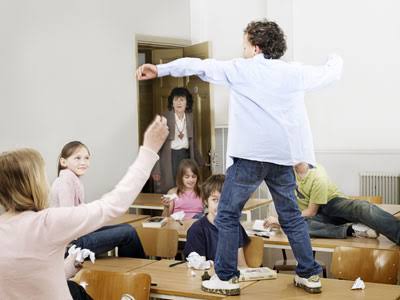It is quite normal for most healthy kids to sometimes be restless and hyperactive. However, when this behaviour becomes excessive coupled with several other factors such as inability to pay attention, impulsiveness and lots more, it calls for attention.
You might be worried about that kid who no matter how much you discipline does what he wants, talks at inappropriate times, interrupt others, acts impulsively and impatiently, asks irrelevant questions, has trouble staying focused, loses things easily, does not pay attention when spoken to, unnecessarily shows fidget and restlessness, makes careless mistakes in school-works with difficulty finishing them. Sometimes, the child is just being a trouble maker.
That child could only be naturally hyperactive with the need of a great deal of patience and good parenting. It could also be possible that the child has Attention Deficit/Hyperactive Disorder (ADHD). There should not be a cause for alarm as long as the symptoms are properly managed. This article will shed more light on what ADHD is and how to care for a child with it.
Attention deficit/hyperactive disorder (ADHD) is a neurodevelopmental disorder that causes developmental impairment of the brain’s self management system, majorly characterized by inattention, hyperactivity and impulsiveness. It affects more males than females and the symptoms can continue to adulthood.
There are 3 types of ADHD;
- Primarily inattentive: The individual tends to be unable to pay attention, disoriented, hardly motivated to do anything and easily distracted and forgetful.
- Primarily hyperactive/impulsive: The individual tends to be hyperactive, impulsive and impatient.
- Combined: The individual has the characteristics of the other two types
Causes and Symptoms
Though genetics may play a role, the exact cause for this neurological disorder is still unknown. Also, exposure of a pregnant woman to certain chemicals, drug abuse and toxins could increase the risk of a child having ADHD. Alas! These substances can affect the fetus’ brain.
Initially, it might be difficult to tell if a child has ADHD as most symptoms are the typical behaviour of young children. Once a child reaches the ages of 5-7, they are expected to pay more attention when being talked to. They should be able to hold themselves from blurting out comments impulsively and sit still when told to do so.
It is also important to note that people with ADHD do not act out these symptoms on purpose. It is rather acted as a result of the inability of their brains to control their behavioural pattern. The symptoms vary depending on the type of ADHD. Acccording to the Diagnostic and Statistical manual of Mental disorders, there are nine specific symptoms for both primarily inattentive ADHD and primarily hyperactive/impulsive ADHD. A child must have at least 6 of these symptoms over a period of at least 6 months and also exhibit them in more than two locations or settings such as the home, school, social gathering etc.
The symptoms of primarily inattentive ADHD are:
- Failure to give close attention to details or making careless mistakes in schoolwork, at work, or during other activities. They overlook or miss details. So, work becomes inaccurate.
- Difficulty sustaining attention in tasks or play activities. They have difficulty remaining focused during lectures, conversations, or lengthy reading.
- Not paying attention when spoken to directly. Their minds seem elsewhere, even in the absence of any obvious distraction.
- Not following through on instructions and failing to finish schoolwork, chores, or duties in the workplace. They start tasks but quickly lose focus, easily leaving things to abandonment.
- Difficulty organizing tasks and activities. They have difficulty managing sequential tasks, keeping materials and belongings in order, doing organized work, being good time managers and meeting deadlines.
- Avoidance or reluctance to engage in tasks that require sustained mental effort. They are reluctant in schoolwork or homework. For older adolescents and adults, preparing reports, completing forms and reviewing lengthy papers become a big deal.
- Losing things necessary for tasks or activities. They often misplace school materials, pencils, books, tools, wallets, keys, paperwork, eyeglasses and mobile telephones.
- Being easily distracted by extraneous stimuli. For older adolescents and adults, it may include unrelated thoughts).
- Forgetfulness in daily activities. They forget doing chores, running errands. For older adolescents and adults, forgetting to return calls, pay bills and keeping appointments is not far fetched.
The symptoms of primarily hyperactive/Impulsive ADHD are:
- Often fidgeting with hand/feet or squirming in seat.
- Often leaving seats in situations when remaining seated is expected. They leave their places in the classroom, in the office or other workplace or in other situations that require remaining in a place).
- Often running about or looking for things to climb in situations where it is inappropriate. In adolescents or adults, this may be limited to feeling restless.
- Being unable to play or engage in leisure activities quietly.
- Being always on the hook. I.e. acting maniacally “driven by a motor.” They might find it pretty hard to be still for quite a long time, even in restaurants or meetings.
- Often talking excessively.
- Often blurting out answers before the completion of questions. They complete people’s sentences; they cannot wait to take turns in conversation.
- Difficulty waiting for turns. They take waiting on queue or line for eternity. Meaning that, they seem not to stand the patience of staying through.
- Interruption or intrusion on others. They butt into conversations, games, or activities. They can even get to the point of using other people’s things without asking or receiving permission. For adolescents and adults, they may intrude or take over what others are doing.
Source: Association, American Psychiatric, ed. Diagnostic and Statistical Manual of Mental Disorders: DSM-5. Washington: American Psychiatric, 2014.
Treatment.
As the cause of ADHD is unknown, there is also no known cure. However, certain treatments can help manage the symptoms and improve the behavioural pattern of the child. Before concluding that a child has ADHD, it is important to see a psychiatrist because a child can be impulsive, hyperactive and unable to pay attention and still not have ADHD. There are a lot of conditions that can have the same symptoms as ADHD e.g psychological disorder such as anxiety, depression, etc. Other differing conditions include: sleep disorders, coping with traumatic event like bullying and relocation or separation from a loved one. Treatments include;
- Therapy ( A psychiatrist can table out a suitable therapy plan and the child’s teacher should also be carried along in the plan to help improve behaviour in school)
- Good diets. Make sure the child eat healthily as this can improve the brain function. Also, dietary supplements with Omega 3 fatty acids have some benefits.
- Your physician might recommend certain drugs called stimulants for children below 6 years and non stimulant for children above 6 years to help control hyperactivity and impulsiveness. They can also help to increase the child’s attentiveness. As the child grows, the drugs may stop working. So, always carry your physician along to ensure the treatment plan is fully appropriated.
- Teach the child social relation and how to make friends.
- Encourage the child and show love to them. Do not be too harsh as this can worsen the child’s symptoms.
- Lay down clear rules and let the child know the implications of breaking those rules.
- A child with ADHD should always get plenty of sleep.
- Reduce the child’s screen time from phones, television and computer as the light from these gadgets causes more melatonin to be produced in the body and this reduces the activity of the brain. These treatments can help manage the symptoms of ADHD and also reduce the chances of the symptoms continuing into adulthood as ADHD often continues into adulthood in 60 percent of children. Untreated ADHD in adults can have a lot of negative impact such as depression, low self esteem and other behavioral disorders. However, these symptoms can get better with treatment. As time goes by, the treatment can be stopped.
Also it is advisable to enroll the child in schools that take such individuals into consideration. Because this can help a lot as more routine to improve behavioural patterns would be put in place.
[CP_APP_HOUR_BOOKING id=”1″]


Oyewole Ibukun is currently a Medical student of Olabisi Onabanjo University. She has a passion for seeking knowledge with a creative, detail oriented and analytical mindset.




